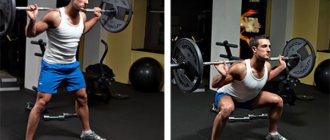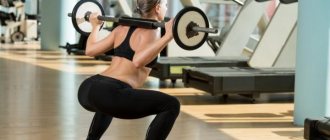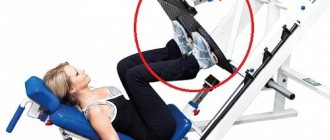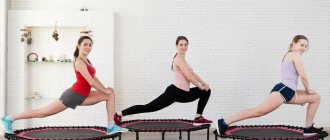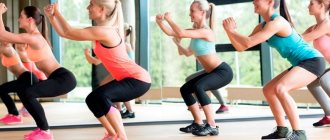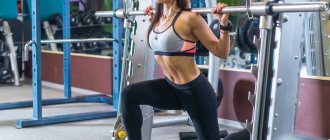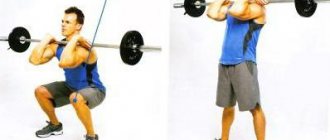Barbell squats are the main tool in building powerful, bulky leg muscles. This exercise is multifaceted not only from the point of view of variability of execution (classical, frontal, in the Smith machine, with dumbbells, plie, and so on), but also from the point of view of the amplitude of movement. Most of the controversy is about deep squats. Their supporters talk about more detailed development of the leg muscles, associating it with a greater amplitude of movement, while opponents argue that this type of squats puts more stress on the knees, and, therefore, is more dangerous. Where is the truth? Let's try to figure it out.
What muscles work
A deep squat with a barbell differs from classic squats only in the amplitude of movement, so it cannot be said that fundamentally different muscle groups are involved. The only difference is the number of muscle fibers worked.
So, when performing deep squats with a barbell, they work:
- Quadriceps;
- Gluteus maximus muscles;
- Adductor muscles;
- Calf muscles;
- Back muscles (especially the lower back), which act as stabilizers;
- The abdominal muscles, like the back muscles, act as stabilizers.
Deep squats[edit | edit code]
Posted by BJ Gaddour
In everyday life you have to squat all the time. Literally everything depends on your ability to squat: how you sit down, stand up, walk, run, jump, step up and lunge.
In many cultures, deep squatting is a posture for rest and relaxation, but in a high-tech society with a predominantly sedentary lifestyle, this is not the case at all. If you work at a desk, the deepest squat you do in a day is determined by the depth of your chair or chair. This is why most people have no idea what a real deep squat is. This is not a position in which the thighs are parallel to the floor. A deep squat is when the back of the thighs rests on the calves and the lower back is not too rounded. Proper execution of a deep squat requires stability of the muscular corset, mobility of the upper spine, ankle and hip joints. When performing a deep squat, you need to bend your knees completely, and most of us are unable to do this without experiencing pain or at least a disc fort. Many people do not take a deep squat position for many years, which leads to soft tissue overgrowing the knee joints, limiting the range of motion, and even deteriorating mobility. It's no wonder that many people complain of arthritis and knee pain.
To get the most out of deep squats, you need to take your time and think less about the number of repetitions and more about increasing the range of motion.
Your goal is to learn how to squat deeply. Your knees and lower back will become so flexible that you will be able to hold a deep squat pose for 5-10 minutes without a break. If the topic of improving health and improving your well-being does not excite you, then remember: the ability to squat is the fastest way to a beautiful appearance.
Deep Squat Progression
| Level 1 Complete zero | Level 2 Elementary | Level 3 Intermediate | Level 4 Advanced | Level 5 Superhero |
| Wall Squat | Squats on a step platform | Deep squat | Deep squat with arms overhead | Squat Jump |
Advantages and disadvantages
Opponents of deep squats talk about their negative impact on the knee joints and, as a consequence, an increased risk of diseases such as osteoarthritis and osteochondrosis.
However, studies conducted in 2013 showed that in the lower phase of squats, when the pelvis drops below the level of the knees, the load on the anterior cruciate ligament of the knee not only does not increase, but, on the contrary, becomes less. At the same time, it was found that the knee joint experiences the greatest loads during shallow squats, when in the negative phase of movement the pelvis does not fall below the level of the knee joints.
Due to the long range of motion, deep squats use more muscle fibers than partial squats. This is especially true for the quadriceps and gluteus maximus muscles, since they are the ones that receive the greatest stretch at the bottom.
Thus, among the main advantages of a deep squat are:
- better training of target muscle groups;
- and less harm to the knee joints.
Perhaps the main disadvantage of this exercise, many will call the inability to work with the same weights as with partial squats. Indeed, if you squat with a barbell weight of 150 kilograms in an incomplete amplitude, then with deep squats you are unlikely to be able to squeeze the same weight from the bottom point. However, it is important to understand that it is better to squat well with a weight of 120 kilograms than to stroke your ego with a squat with a barbell weighing 150, thereby harming your knees.
Varieties of exercise
Deep squats with a barbell
If you have perfectly mastered the basic exercise and want to not only maintain shape, but progress, it’s time to move to the next level. With a barbell, deep squats for the buttocks and thighs are doubly useful. They are performed in two ways:
- with a barbell behind your back;
- with a barbell on your chest.
In the first case, the projectile should be located on the upper back. And under no circumstances on the neck! We take the bar with a grip from ourselves. You can't relax your back. Ideally, a special athletic belt is needed. In the second option, the barbell is taken with a grip from yourself (pros prefer a cross grip).
Otherwise, the technique is the same as in classic deep squats. However, such a workout should be preceded by a good warm-up. To do this, it will be useful to perform hyperextension in 2-3 approaches of 15-20 times.
It is better to start with an empty bar (especially for girls), squatting until parallel to the floor. In the future, this will be a basic element of every warm-up. The working weight is usually selected by the trainer. But there is a universal rule for beginners. We throw a couple of 10 kg weights onto the bar, which, taking into account its weight, gives us a total of 40 kg. If after 8-9 repetitions the strength is running out, this is your weight. Otherwise, we add another 5 kg and perform the next set until we find the optimal load.
In total, you need to perform 3-4 hikes of 15 repetitions per workout.
Goblet Squats
Goblet squats are an ideal exercise for girls who dream of slender legs. And after them it will be easier for men to master the barbell. They are done with a weight that is held by the sides of the arms in bent arms at chest level (but does not touch it). Instead of a weight, any weighty object of a compact shape can be used: a heavy dumbbell, a barbell plate, a medicine ball, etc. The weight of the apparatus is selected in such a way that the exercise can be performed with it without violating the technique.
Standard number of repetitions: 10–15 in 3–4 sets.
Plie squats
This is another interesting variation of deep squats that helps work out the problem area of the inner thigh. A significant difference from the classic version is the wide stance of the legs with the knees spread to the sides. Hands folded in front of the chest or lying on the knees. In this case, the pelvis is not retracted, although this option is also acceptable. But these will be sumo squats, which, however, are no worse.
Plie squats are also performed with a kettlebell or dumbbell held suspended between the legs. Or you can test your strength with a barbell. Girls perform 3 sets of 10 repetitions. Men – 3 to 15.
Execution technique
The technique of deep squats, as well as mistakes when performing them, are almost identical to the classic ones.
So, the correct technique is:
- Take a starting position standing with your feet shoulder-width apart and your toes slightly apart.
- Keep your back straight, slightly arched at the lower back.
- Remove the barbell from the racks by placing it on the trapezius muscles. The removal is performed using the strength of the legs, not the back.
- Step back a little (1-2 steps).
- Once in your starting position, make sure your feet are shoulder-width apart and the barbell is securely locked.
- As you inhale, perform a deep squat. The pelvis should fall below the level of the knees as far as possible.
- Fix at the bottom point for 0.5-1 second.
- As you exhale, return to the starting position.
- Go to the racks and place the barbell on them. Returning the barbell to the racks, as well as removing it, is carried out using the strength of the legs.
Wall Squat[edit | edit code]
Wall squat
Wall squat
- This is an exercise that everyone can do, especially if you allow yourself to increase the level of your hips relative to your knees as needed.
This is a truly safe, reliable and low-skill way to perform squats while maintaining proper body position. The upright position of the torso puts more stress on the quadriceps muscles of the thighs, helping to pump up the muscles around the knee joints. This is especially important for people who have had knee diseases or injuries. Isometric squat holds are easier on sore joints than dynamic, full-range squat repetitions. Although this exercise belongs to the first level of difficulty, well-trained athletes can continue to do it for the purpose of
warming up, active recovery between workouts, or for endurance work. Additionally, if you squat deeply enough and drop your hips below your knees, this exercise can be challenging for even the fittest of us. If you can't practice near a wall, use any stable surface that is perpendicular to the floor, such as a door or even a pole.
Performance
Initial position
- Stand against a wall with your feet shoulder-width apart.
- Maintain the natural height of the arches of your feet (three-point support).
- Raise your hands in front of you.
- Toes should be facing forward, although if necessary, it is permissible to move them apart by 10-20 degrees.
Perfect execution
- Squat so that your upper thighs are parallel to the floor and your pelvis, upper back and head are completely touching the wall.
- Keep your back as straight as possible and fix this position for a while.
- If you get tired ahead of time, simply reduce the range of motion.
Target
Before moving to the next level, you should be able to hold the wall squat position several times for 60 seconds, lowering your hips below your knees.
Regression (decrease) of exercise difficulty
- Easier option
: Lower yourself so that your knees bend at a 60-75 degree angle.
- An even easier option
: Lower yourself so that your knees bend at a 30-45 degree angle.
- The easiest option
: Lower yourself so that the bend angle of your knees is 10-15 degrees.
Progression (increase) of exercise difficulty
- More challenging
: Increase your range of motion by lowering your hips below your knees.
- An even more difficult option
: Bring your legs together until they touch completely.
- The hardest option
: Wrap your arms around your shoulders in a criss-cross pattern (or keep your hands at your chest in a prayer position). You can also clasp your hands at the back of your head (prisoner pose) or raise them above your head.
Squats on a step platform[edit | edit code]
Squats on a step platform
Squats on a step platform
- a very important exercise to gain self-confidence and prepare for more difficult exercises. Besides, this is an exercise you have to do in real life every time you sit down and stand up on something. The back squat process has a built-in self-correction mechanism that instantly corrects your technique by forcing you to lean at the hips before bending at the knees. Any training squat should be performed in the same way. To maintain knee health, it is important to keep your shins as close to vertical as possible during the squat process. This exercise also allows you to easily adjust the difficulty level by increasing or decreasing the height of the step platform. Therefore, the squat should be a staple of your lower-body training program, no matter what your current fitness level. Additionally, it serves as an excellent tool for preparing for single-leg squats.
Performance
Initial position
- With your feet wide apart and your feet in three-point position, stand in front of the step platform. Its height should be such that when sitting, the upper surface of the thighs is parallel to the floor.
- Toes should be pointed forward, although you can point them out a little if necessary.
- Take a hollow body pose: tighten your thigh muscles, gluteal muscles and abdominal muscles, pull your chest and shoulders down.
Perfect execution
- Move your pelvis back as far as possible (as if you were closing a door with it).
- With your thigh muscles fully stretched and engaged, bend your knees and slowly sit down on the step platform.
- Hold the lower position for a while, maintaining tension throughout your entire body, and then lean forward and stand up, squeezing your gluteal muscles.
Target
You should be able to complete several sets of 10 reps before moving on to the next level.
Regression (decrease) of exercise difficulty
- Easier option
: Reduce the range of motion by increasing the height of the step platform so that your hips are higher than your knees when sitting.
- An even easier option
: Increase the height of the step platform even more.
- The easiest option
: Help yourself by holding on to the support with your hands. This will allow you to recruit the muscles of the upper half of the body to help the muscles of the lower half of the body as necessary and perform the exercise with full amplitude.
Progression (increase) of exercise difficulty
- More challenging
: Increase your range of motion by lowering the height of the step platform so that your hips drop below your knees when seated.
- Even more difficult option
: Reduce the height of the step platform even more.
- The most difficult option
: Perform deep squats on the step platform, reducing it so that in a sitting position the lower side of the thighs rests on the calves. As a result, the range of movements is the same as with deep squats without a step platform.
Advice
Use an adjustable aerobics step platform as it allows you to quickly change the height of the stand a few centimeters at a time. It is especially useful when performing deep squats on a step platform since it can be lowered very low, to the floor itself, which is what is needed when performing such an exercise. If you don’t have an adjustable step platform at hand, any stable box, chair, bench or sofa will do.
Deep squat[edit | edit code]
Deep Squat
The beauty of weight-free exercises is that you don't need dumbbells or barbells to do them. You can simply focus on gradually increasing your range of motion, inch by inch. With gradual progress, you will be able to reach your full potential while protecting your back and knees. At first, limit the depth of the squat to the point beyond which you can no longer help but bend at the waist. Your first goal
The depth of the squat should be such that the upper surface of the thighs is parallel to the floor and the hip joints are at the same level as the knees (a). The next step is to reach a depth where your hips drop below your knees. Finally, the last step is to lower yourself so low that the underside of your thighs rests on your calves (b). Take your time because the deep squat is one of the most important fitness standards.
At a certain squat depth, the knees will move forward as a result of flexion of the ankle joints. Try to avoid this. To avoid injury to the calf and other calf muscles, try to keep your shins in a position close to vertical
Performance
Initial position
- Spread your legs shoulder-width apart and maintain a three-point position with your feet. Toes should be pointed forward, although you can point them out a little if necessary.
- The head is in a neutral position (ears, shoulder, hip and ankle joints are on the same vertical line). The gaze is directed forward.
- Take a hollow body pose: tighten your thigh muscles, gluteal muscles and abdominal muscles, pull your chest and shoulders down.
Perfect execution
- Move your pelvis back as far as possible (as if you were closing a door with it).
- With your thigh muscles fully stretched and engaged, bend your knees and slowly squat down. Go as low as you can without bending too much at the waist.
- Hold the lower position for a while, maintaining tension throughout your entire body, and then lean forward and stand up, squeezing your gluteal muscles.
Target
You should be able to complete several sets of 10 reps before moving on to the next level.
Regression (decrease) of exercise difficulty
- Easier Option
: Reduce your range of motion, lowering yourself until your upper thighs are parallel to the floor.
- An even easier option
: Squat so that you can maintain a neutral spine without experiencing pain in your knees.
- The easiest option
: Help yourself by holding on to the support with your hands. This will allow you to recruit the muscles of the upper half of the body to help the muscles of the lower half of the body as necessary and perform the exercise with full amplitude.
Progression (increase) of exercise difficulty
- More challenging
: Increase your range of motion by squatting so that your hips drop below your knees when seated.
- Even more difficult option
: Squat so that the lower side of your thighs in a sitting position rests on your calves (b).
- Hardest Option
: Further increase range of motion by bringing your legs closer together. This variation allows you to increase mobility in your ankles and hips and gradually prepares you for performing single-leg pistol squats.
Deep squat with arms overhead[edit | edit code]
Deep Overhead Squat
By this point, you've already gained the necessary level of mobility in your ankles, knees, and hips, but when you raise your arms overhead while squatting, it's a bit of a game changer. Most people in this situation arch their back excessively and allow their chest to rise, putting their back and shoulders at risk of injury. When performing squats with your arms raised above your head, you need to tighten your muscle corset as much as possible, pull your chest and shoulders down and have significant mobility of the thoracic spine. Squat to a depth that allows you to maintain a safe, neutral spine position.
Sitting at a computer all day can cause constant tension in your pecs, latissimus dorsi, and shoulders, which can make it very difficult for you to lift your arms above your head correctly. In this case, try this trick: take an elastic band and actively stretch it, as if you are trying to tear it in two. This will make it easier for you to hold your arms above your head correctly, as it stabilizes your shoulders and activates your upper back muscles.
Performance
Initial position
- Spread your legs shoulder-width apart and maintain a three-point position with your feet. Toes should be pointed forward, although you can point them out a little if necessary.
- Take a hollow body pose: tighten your thigh muscles, gluteal muscles and abdominal muscles, pull your chest and shoulders down.
- Raise your arms above your head without excessively arching your lower back.
Perfect execution
- Move your pelvis back as far as possible (as if you were closing a door with it).
- With your thigh muscles fully stretched and engaged, bend your knees and slowly squat down. Go as low as you can without bending too much at the waist.
- Hold the lower position for a while, maintaining tension throughout your entire body, and then lean forward and stand up, squeezing your gluteal muscles.
Target
You should be able to complete several sets of 10 reps before moving on to the next level.
Regression (decrease) of exercise difficulty
- Easier option
: Sit on a step platform low enough so that your thighs touch your calves at the lowest point.
- An even easier option
: Perform deep squats in a prisoner position, placing your hands on the back of your head and squeezing your shoulder blades together.
- Easiest option
: Perform deep squats in prayer pose with your hands folded in front of your chest.
Progression (increase) of exercise difficulty
- More difficult option
: Bring your hands closer and closer until they touch completely (ideally). If your palms are facing each other, it will be easier to stabilize your shoulders.
- An even more difficult option
: Bring your legs together until they touch completely.
- The most difficult option
: Bring your arms and legs together until they touch completely.
Squat jump[edit | edit code]
Squat Jump
Now that you have mastered the deep squat technique, it's time to start developing leg strength. Give the exercise an explosive nature by jumping from the bottom position and lifting your legs off the floor. Each time you lift your feet off the floor, once you land, you will have a harder time regaining your three-point foot position, keeping your shins upright, and keeping your knees apart.
To master the technique of performing this exercise, lower yourself so that the upper surface of your thighs are parallel to the floor. Lock this position for 5 seconds. This will negate the effect of the stretch, forcing the muscles to work harder while relieving tension on the joints and connective tissue. Once you gain experience and strength, you will be able to perform squat jumps without pausing in the lower position. Partial squat jumps aren't just a regression. If you are involved in a sport that requires particularly explosive action, partial squat jumps with minimal knee and hip flexion can come in handy and have a place in your training program.
Performance
Initial position
- Spread your legs hip- or shoulder-width apart. Toes should be pointed forward, although you can point them out a little if necessary.
- Keep your head in a neutral position. Stretch your arms in front of you.
- Take a hollow body pose: tighten your thigh muscles, gluteal muscles and abdominal muscles, pull your chest and shoulders down.
Perfect execution
- Move your pelvis back as far as possible (as if you were closing a door with it).
- With your thigh muscles fully stretched and engaged, bend your knees and slowly squat down. Go as low as you can without bending too much at the waist.
- Hold the bottom position for 5 seconds, then jump as high as you can before landing softly in the bottom position.
Target
You should be able to perform several sets of 10 repetitions, achieving significant jumping heights and achieving super soft landings.
Regression (decrease) of exercise difficulty
- Easier Option
: Perform partial squat jumps, squatting just enough to maintain a neutral spine without causing knee pain.
- An even easier option
: While sitting on a step platform, jump up and then land in the
Starting position
. Not only does this allow for self-correcting form, but it also puts less stress on your joints and allows you to build up an initial reserve of strength as you jump out of a rigid position.
- Easiest option
: Help yourself by holding onto the handrails (training loops, pole, etc.) with your hands, which allows you to perform the exercise with full amplitude.
Progression (increase) of exercise difficulty
- More difficult variation
: Squat deep enough so that your hips drop below your knees. If you are able to squat as deep as possible with your thighs touching your calves, try not to spring into your calves as this puts undue stress on your knees. It is better to take a short pause in the lower position and then jump out.
- Even more difficult option
: Jump from a position where the toe of one foot is level with the heel of the other foot. You can do all the reps and then switch legs or alternate legs in flight after each jump.
- The most difficult option
: Jump up from the bottom lunge position (kneading). The front leg should be on the floor with the entire foot, and the back leg should rest on the toe. You can do all the reps and then switch legs or alternate legs in flight after each jump.
Common mistakes
- Insufficient attention to the position of the back. Often, under the influence of the weight of the barbell in one of the phases of movement, novice athletes begin to slouch, which can lead to a back injury.
- Shift of the center of gravity. This error is more common in the positive phase of the movement, when the athlete, trying to lift the weight, shifts the load to the toes, thereby increasing the risk of losing balance.
- Working with too much weight. Many gym goers, especially novice athletes, often chase heavy working weights, naively thinking that by doing so they will demonstrate their strength. In fact, working with too much weight impairs the technique of performing the exercise, which can lead to various types of injuries.
Problems and their solutions
The first reason is the lack of experience (relevant for beginners) or the basic ignorance of the correct technique by experienced trainees (people with experience in squats often perform this exercise incorrectly only because they have not realized how to perform it correctly). This reason can be easily eliminated by training the correct movement technique with the help of an instructor or a competent partner; or by practicing on your own against a wall.
In solving this issue, an important place is occupied by the distance between the feet and the presence / absence of a base under the heels. When performing the test, experiment with narrow, regular and wide spacing. Obviously, one of them will be the most convenient, and the other of them will be the least convenient. This way you can understand what distance between your feet is right for you. The same applies to the need to place a platform under the heels.
The second reason is anatomical, usually associated with an unusual proportion of the length of the thigh and lower leg or the long length of the legs relative to the length of the torso, characteristic of tall ectomorphs. With such physiological conditions, it is very often simply impossible to squat so that the knees remain within the desired range. But in this case, a slight protrusion of the knees forward will be within normal limits. However, it is worth knowing that it is difficult for such athletes to perform deep squats with heavy weights, it is easy to get injured, and the difference in working weights for full and partial amplitude will be huge.
And the third reason (the most likely) is insufficient mobility (plasticity, flexibility) of the ankle joint. The more mobile it is, the easier it is to hold the shin at a given angle during squats. The less mobile it is, the more the back comes into play to help hold the shin at the desired angle, bending forward for this purpose. In our test, the body will rest against the wall, and it will not be possible to bend over.
You can check whether you have this problem with another similar test: stand against a wall at a distance of 13-15 cm (the taller you are, the greater the distance) and, without lifting your heels (!), try to touch your knees to the wall. It would be correct to test the test with both feet at once and one at a time. If you can reach the wall with your knees, then everything is fine with your joint mobility. If not, then there is a high probability that the squat is an uncomfortable exercise for you, and your technique is lame, and there is an increased risk of injury. What to do if the proposed test fails. In this case, it is necessary to stretch the lower leg - the soleus, peroneus and gastrocnemius muscles. This can be done at any time, but most importantly, it must be done before the squats themselves. There is a lot of information on the Internet about how to stretch the muscles of the lower leg and ankle joint.
Types of deep squats
The most common type of deep squat is the barbell squat, but alternatives include using dumbbells, kettlebells, or a Smith machine.
Deep squats with dumbbells are mainly used by girls or beginners who are not yet physically ready to perform the exercise with a barbell. As a rule, one dumbbell is used, which the athlete holds vertically in front of him, taking it by one of the weights at the base. When using two dumbbells, the apparatus is placed on the shoulders.
A deep squat with a kettlebell is also most often used by girls or beginners, placing it in front of them, as in the case of a dumbbell. If 2 weights are used, the athlete places them on the shoulders.
Deep squats in the Smith machine are aimed primarily at understanding and improving the technique of this exercise. In addition, this type of deep squat is useful for those who experience discomfort in the lower back when squatting with a barbell, since the Smith machine minimizes the work of the stabilizer muscles.
Scientists' conclusions about the effectiveness of squat depth
The results of the study show that full squat training is more effective for developing the muscles of the lower extremities, with the exception of the rectus femoris and hamstring muscles. If the goal of performing squats is to develop the gluteal and adductor muscles, then the full amplitude is preferable. In practice, due to individual anatomy, full squats may provide little benefit in developing the buttocks for some, although it will still be better than half-amplitude squats. When the goal is maximum hypertrophy, for the full development of the hip, squats alone are not enough. A little isolation wouldn’t hurt, for example, flexions or hyperextensions for the hamstrings and extensions; in them, the rectus muscle works more efficiently than in different variations of squats.
Squats for girls
The squat is a completely natural and familiar body movement to each of us. Every day a person squats down on a chair several times to pick something up from the floor, without thinking that the muscles of the entire lower part of the body are working.
It is impossible to get injured when squatting naturally, which is an additional advantage for including this exercise in your training list.
What are the benefits of squats?
In addition to the benefits for the figure, exercise has a positive effect on the entire body. There are several important advantages of squats for girls:
- Strengthens the gluteal and thigh muscles, making the lower body slim and toned
- Strengthens core muscles, promoting abdominal development
- Increases the concentration of growth hormone in the blood, due to which muscles grow faster and relief is formed
- Improves posture as it strengthens the back muscles
- Develops flexibility of the hip joints
- Accelerate metabolism, improving lymph and blood flow and eliminating cellulite
- Strengthens ligaments and joints
- Helps develop speed and explosive power
- Develop balance and coordination of movements
Squats with the correct technique have a strengthening effect on the entire body, but the wrong technique can negate all the positive aspects of this exercise.
How to squat correctly?
When performing any exercise, correct technique plays a paramount role, since the effectiveness of the workout depends on it. There is a universal squat technique for girls, once you study it you will never make mistakes when performing this super useful exercise.
- From a standing position, place your feet slightly wider than shoulder width. Keep your back straight, do not raise your shoulders, they should be relaxed and slightly lowered.
- For balance, keep your arms in front of you. Beginners are advised to clasp their hands in front of them or extend their arms straight forward, as in this position it is easiest to maintain balance and ideal body position when squatting.
- Start squatting by moving your pelvis back and bending your knees. Lower yourself back, as if trying to sit on an invisible chair, in this position your thighs will be parallel to the floor.
- Make sure that your knees do not protrude beyond your toes, otherwise there will be excess stress on the joints and minimal stress on the muscles.
- Squat down until your thighs are parallel to the floor. A deep squat (below parallel to the floor) is considered an effective exercise for the buttocks, but it puts a lot of stress on the knees, and therefore is not recommended for overweight people and anyone with problematic joints.
- Shift your body weight into your heels to maximally target your glutes, hamstrings, and calves. When straightening, push with your heels, not your toes, this is very important!
- Always look straight ahead, as a dropped chin will cause your neck and back to round, which will negatively affect your technique.
- Fix for a few seconds at the lowest point so that the body remembers the correct position.
- Always control your breathing during squats. Take a deep breath as you lower into the squat. Exhale as you rise from a squat.
- Practice squatting in profile in front of the mirror to see all the shortcomings and correct them in time.
Regular training will help you learn how to squat correctly, and for this you do not have to go to the gym, because this universal exercise is perfect for home fitness.
Correct squat position:
- Knees do not go forward of socks
- Heels don't leave the floor
- Body weight is transferred to the heels
- The abdominal and buttock muscles are tense
- Straight back, no stoop in the thoracic region
- The pelvis is laid back without rounding the lower back
- Gaze forward
- Shoulders are dropped, neck is not rounded
- Thighs parallel to the floor (at least)
- Knees turned outward
Squat hand position options:
- Experienced athletes can hold their hands in any position as long as there are no flaws in their technique.
- For beginners, it is better to clasp your hands. This is the simplest hand position that will help you easily master squats and hone your technique.
- If you find it difficult to maintain balance at first, you can stretch your arms in front of you. This position of the hands during a squat best helps to maintain balance.
- If you round your lower back during a squat, you can place your hands behind your head to help avoid rounding your lower back. However, it is better not to choose this position of your hands if you have not yet learned to maintain balance by transferring your weight from your toes to your heels.
What muscles work during squats?
Squatting, as one of the basic exercises, works all muscle groups of the lower body. In some types of squats for girls, the muscles of the arms, shoulder girdle and back are additionally used, for example, during a goblet squat or a classic squat with a barbell on the shoulders.
When performing a classic squat without additional equipment and weights, the following muscles work:
- Quadriceps or quadriceps muscles of the thighs, which take on the main load
- The biceps or biceps femoris muscles tighten as you lower your body down.
- The gluteus maximus muscles help straighten the body
- The hamstring muscles help flex and extend the knees
- The calf muscles are responsible for balancing the body during exercise.
- Core (lower back and abdominal muscles) helps keep your back straight and balance
- Back extensors straighten the spinal column and keep the torso upright
With the correct squatting technique, almost all muscle groups are included in the work, receiving a natural and healthy load necessary for their growth and strengthening. Squats are most useful for the buttocks, as they help build muscles in this part of the body and create a beautiful shape. The legs also gain definition and a toned appearance. When squats with weights, the abs and back are also pumped up.
Who are contraindicated for squats?
Despite the fact that squats are one of the most beneficial exercises for health and fitness, in some cases it is not recommended to do it. There are several common cases when it is better to avoid squats:
- problems with joints, especially knees, ankles, hips
- large excess weight, which causes stress on the knees
- diseases of the spine for which physical activity is prohibited
- hernias and injuries of the spine, pelvis
- varicose veins and other vascular problems
- high blood pressure
Squats with heavy weights are not recommended for any disorders of the cardiovascular system, problems with the musculoskeletal system, or in the presence of chronic diseases. Squats without weight in similar situations can only be done with a doctor’s permission.
If you're not sure how your body will respond to squats, you can start with half squats for beginners, which will allow you to gradually adapt your body to physical activity:
Anderson Squat (from the bottom)
Everything is as usual - but you start from the bottom, removing the barbell from the stops/plates with each repetition.
If the squat from the bottom point is significantly less than from the top, then you have a problem with the development of force in the muscles of the pelvic girdle. In this case, the inclusion of the Anderson squat in the program will contribute to the growth of records in the traditional one.
pros
Although a similar effect can be achieved with a regular paused squat, the Anderson squat better trains the working muscles to develop force when lifting from the bottom.
Mobility of the hip joints develops; Simply descending into a full squat without load is already an achievement for many. Transfers well to the deadlift as you are no longer relying on the stretch reflex like a regular squat.
Minuses
Of course, there are also disadvantages: you already need to have sufficient mobility of the shoulder and pelvic girdle to assume the starting position. And, of course, first you will have to significantly reduce the working weight, which will underload the upper part of the amplitude.
For whom is it more effective?
I rarely prescribe it as a main exercise, but the Anderson squat is a great addition to the program for those who get stuck at the bottom of a regular squat or have difficulty lifting the barbell off the platform in the deadlift.
